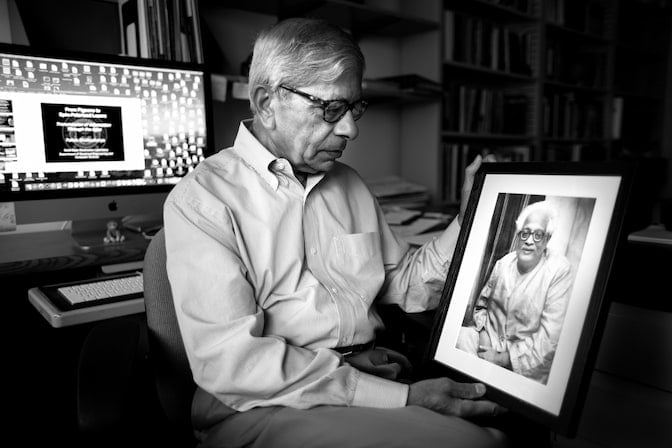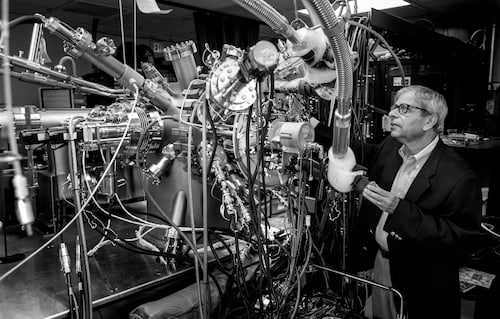
Advancing quantum-dot and integrated optoelectronics
NAE profile: Pallab Bhattacharya, electrical engineering and computer science

NAE profile: Pallab Bhattacharya, electrical engineering and computer science
Get to know Michigan Engineering’s National Academy of Engineering members.
Pallab Bhattacharya has been pivotal in the field of optoelectronics. At the University of Michigan he established experimental facilities with molecular beam epitaxy (MBE). Notably, he led the development and commercialization of quantum dot lasers, discovering self-organized quantum dots, and demonstrated their room temperature operation. He counts semiconductor spin valves among his innovations. Bhattacharya authored over 1,000 articles, holds three patents, and has become a renowned professor, graduating 81 Ph.D. students who he is proud to say are becoming industry leaders. His accolades include the IEEE Jun-ichi Nishizawa Medal.
For these achievements, Pallab Bhattacharya was elected to the National Academy of Engineering in 2008. View the NAE citation.
More on Pallab Bhattacharya

Bhattacharya: I was born in Calcutta, India. My dad was a polymer chemist and he actually worked with the father of polymer chemistry, Herman Mark at the Polytechnic Institute of Brooklyn. Then he went back and worked at a government institute, and that’s where I grew up.
I did my schooling in the Cambridge system. After that, for my undergraduate degree in physics I came back to Calcutta St. Xavier’s College and then did my graduate studies at Calcutta University. I did my graduate studies in a subject called Radial Physics and Electronics. I specialized in and advanced electronics, and then I worked in India as a research scientist.
Bhattacharya: My real interest was optoelectronics and that’s devices like light detectors, lasers, LEDs, light modulators and so on. Those days were very hard for optical fiber communication. We knew that to get the best lasers. We had to use quantum structures, and quantum structures were like quantum wells, quantum wires, quantum dots, and quantum boxes.
The best lasers that exist are ones that depend on transitions in atoms and molecule walls and so on. Unfortunately, they are big and bulky, and they cannot be pumped or driven electrically. They have to be excited by another laser. So we wanted tiny lasers which can be excited and be operated with electrical current. Those are semiconductor lasers. Now, the question was how do we realize these quantum wells are okay? When it came to quantum wires or even quantum dots, we did not know how to incorporate such quantum dots in a semiconductor laser structure.
We tried etching and other things to shape these, but we knew that was not really the technology. We were looking for a technique where, while we are growing the structures in those machines, we also formed the dots and then the rest of the structure. We realized the first room temperature quantum dot lasers. We rushed the manuscript for publication because I knew there were others hot on our heels. And that’s how we became one of the co-inventors of the quantum dot laser. It’s now commercialized. And these lasers are good because their performance doesn’t depend on the ambient temperature. They can be very fast and they can be modulated for communication in applications.
Bhattacharya: Do what you really want to do. Listen to everyone, and, sooner or later you will figure out what you want to do with your life. There may be a couple of changes. You may have to retool. You may have to change course. But that’s alright. Do what you are passionate about.
Bhattacharya: Experimental physical science students and faculty need to put in some extra hours. It’s experimental work and it just cannot be a 9 to 5. I am seeing trends that students are a bit reluctant of this. In my time, in the early days, it was exactly the opposite. All these machines and equipment were to attract them. Now I think they’re a bit reluctant when they see their colleagues doing other things where they don’t have to physically work as hard. This worries me. One really has to be super dedicated and really have to love it for the sake of it to be doing it. Inventions and discoveries and all that happen sometimes by plan, and sometimes accidentally. This country certainly has an edge because it has been very, very innovative. I would hate to see it go away just because we are not putting in all the effort. If we do not maintain the emphasis on this kind of education, then I don’t know what will happen down the food chain.
Quotes edited from interview transcript between Pallab Bhattacharya and Marcin Szczepanski.